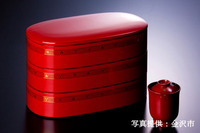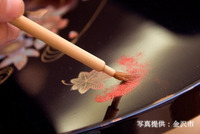

Total:131items
- Pottery & Porcelain (18)
- Lacquerware (4)
- Glasswork (2)
- Wood & Bamboo Work (19)
- Leather Work (1)
- Papermaking (13)
- Textile (20)
- Dyeing products (5)
- Masonry (1)
- Metal Work (11)
- Stationery (4)
- Livingware (3)
- Accessory (4)
- Toys & Entertainment (14)
- Interior (2)
- Other crafts (10)

 |
Main Production Site:Ishikawa |
 《Characteristics》
《Characteristics》The major feature of Kanazawa lacquerware is gorgeous and detailed pattern realized by highly developed maki-e*1) technique.
*1) Maki-e literally means sprinkled artwork, which is done by spreading gold or silver powder onto the wet surface of desiccating lacquerware.
The foundation of Kanazawa lacquerware was established by inviting two master craftsmen; IGARASHI Doho, who was a maki-e master in Kyoto (West Japan) and served for Shogun family in the Muromachi period (1336-1573), and SHIMIZU Kuhei, who was from Edo (present day Tokyo, East Japan).
The characteristic method of undercoating is called “Honkataji-nuri”; going through dozens of processes such as “Nuno-kise” (pasting cloth to reinforce) or “Urushi-shitaji” (base-coating the material to add more smoothness and gloss) on the wooden material prepared using “Sashimono” (cabinetwork), “Hikimono” (turnery) or “Magemono” (round chip box) techniques.
The main finishing techniques of Kanazawa lacquerware are “Mujiroiro-polishing” (adding extra gloss on the plain surface by polishing with charcoal) and Hana-nuri (also called “Nuritate”, leaving the surface unpolished with moderate gloss with oily lacquer). The Kanazawa-specific unique and elegant lacquering technique is used as well.
In addition, all of lacquering decoration techniques such as “Hyomon”; polishing the pasted gold and silver plates on the lacquered material to make emerged patterns, “Raden”; inlaying mother-of-pearl, “Rankaku”; coloring in white with egg’s shell, are handed down to today. They have evolved into the unique lacquer crafts, with a blend of the elegant aristocratic culture and the powerful samurai culture since the Middle Ages.
Even today, Kanazawa lacquerware are hand-crafted one by one, by craftspeople or lacquer artists. Typical products are furnishing goods and tea utensils.
[National designated traditional craft (Designated by the Minister of Economy)]
Information sources: Kanazawa Lacquerware Manufacturers Cooporative Association
Translated by: Namiko Murakami, reviewed by Miwa Odagiri

| Materials | Wood, lacquer, gold or silver, nacre etc. |
|---|---|
| Crafting Processes | [1] Preparation of material and base coating
Starting from the careful selection and preparation of wooden materials, dozens of processes are required even to finish base-coating. [2] Lacquering Evolved as feudal lords’ armors and furnishing goods, the lacquering technique requires preciseness and robustness as well as decorative beauty. [3] Decoration Kanazawa lacquerware uses elaborate and delicate techniques such as Taka maki-e (outstanding patterns with gold and silver) or Shishiai-togidashi maki-e (the combination of Taka maki-e and Togidashi maki-e; applying lacquer thinly after sprinkling powder of gold or silver on the pattern, and polish with charcoal until gold or silver appears). Along with these techniques, other traditional techniques Hyo-mon, Raden and Rankaku are applied for extra decorative effects. |
| History | The origin of Kanazawa lacquerware dates back to the period of MAEDA Toshitsune (the third Kaga domain lord, present day Ishikawa prefecture, Central Japan). He gathered master craftspeople of various fields from Edo, present day Tokyo, or Kyoto to Kaga Domain workshops. Among them, there were Maki-e masters IGARASHI Doho and SHIMIZU Kuhei who brought in their decorative techniques.
The Kanazawa lacquerware was developed as such by the support of Kaga Domain, and became the unique lacquerware with a blend of the elegant aristocratic culture and the powerful samurai culture. This technique was transferred to apprentices of Kaga Domain workshops and craftspeople in the city, and handed down until today. There were more than 200 lacquer craftspeople in the early Showa period (20c). However, the number of them sharply decreased during the World WarⅡ. After the war, the value of this technique was rediscovered in accordance with the economic reconstruction. Today, training of successors and exhibitions are conducted proactively. |
◆Exhibition / Showcase
Kanazawa Lacquerware Manufacturers Cooperative Association
9-13 Oyama Town, Kanazawa City, Ishikawa Prefecture
920-0918
TEL: +81(0)76-263-1157 (Japanese only)
◆Event Information
Assistance needed? For inquiries in English:
JTCO Contact Form
Your inquiries will be forwarded by JTCO in Japanese to the organization you wish to contact.
*Please write the name of craft you wish to ask about.



